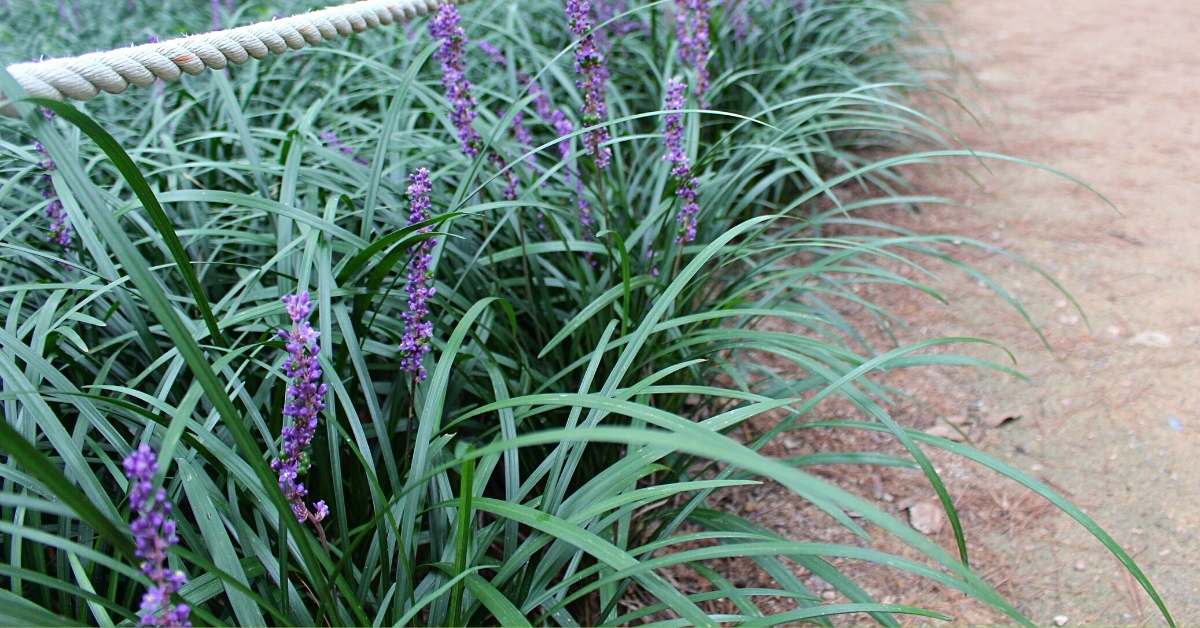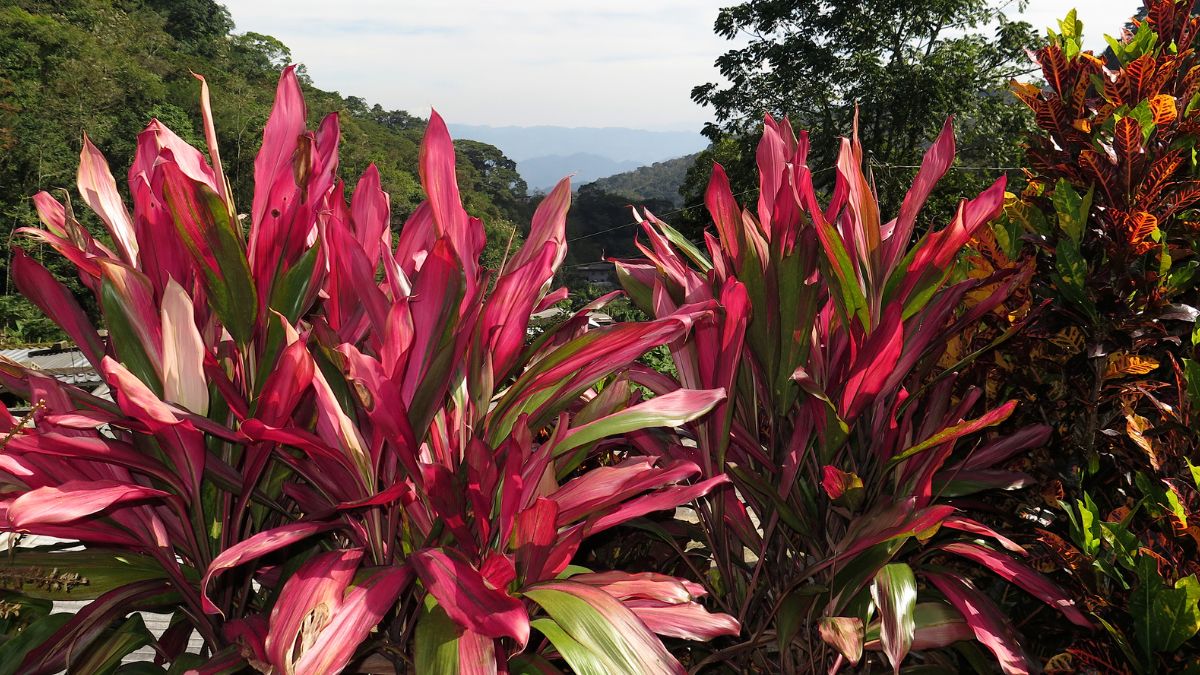If your garden’s live walls and ceiling are trees, bushes, and hedges, groundcovers and pavement make up the majority of its floor. A strip of land between a bluestone pathway and a gravel driveway in my yard is a near-perfect site for one of the most indestructible and gorgeous groundcovers: Creeping lilyturf.
Neither a lily nor a grass, Liriope spicata is a grassy-leaved spreading perennial. I’ve gone over my swathe with a rake to remove the last of Fall’s leaves. The raking also smooths the long foliage down, showing off the season’s first snow flurry. It also makes clear just how long the lilyturf foliage is:
The walkway is three feet wide, and more than half the width is now sporting a lilyturf comb-over.
The leaves hold more of an arch in warm weather, giving this groundcover the look of an unusually vigorous no-mow lawn. Vigor is both lilyturf’s curse and blessing. Clumps fill in to form a seamless patch in just a year or two—or even months if you are willing to plant more closely.
But the same quick-growing, far-reaching roots that knit the clumps into a sod-like colony don’t stop when growth has filled the space you want. In the picture below, roots that reach almost all the way beneath the three-foot bluestones send up tufts of green leaves through the narrowest of cracks.
If the roots reach the box hedge at the left, let alone the perennial bed it bounds, they could soon overrun it. Lifting the heavy stones to extract the out-of-bounds lilyturf would be quite a chore. In Spring, I’ll paint these almost-escaped shoots with Round-Up.

Here’s the specifications and how to grow this tough groundcover Creeping Lilyturf:
Latin Name
Liriope spicata
Common Name
Lilyturf
Family
Asparagaceae, the Asparagus family.
What kind of plant is Liriope Spicata?
Low rhizomatous perennial with dense and virtually weed-proof foliage that is evergreen in Zone 7 and warmer, and only reluctantly deciduous in Zone 6 and colder.
Hardiness
Zones 4 – 10
Habit
Ground covering and ever-expanding. Thanks to the profuse and outward-bound rhizomes, Liriope spicata spreads quickly and, when inappropriately sited, relentlessly.
Slender but thick leaves emerge vertically but soon grow too tall to remain erect. Instead, they arch over gracefully. This arch is fortuitous, not just attractive. Indeed, it’s the main reason that Liriope spicata is such an effective groundcover. The merely thick growth usually isn’t enough.
A groundcover whose dense growth remains erect—such as true turf grass—still permits the sun to penetrate to minute areas of exposed earth, where seeds can receive enough light to germinate. Only with your diligent intervention can your lawn escape infestation with weeds.
But the countless arching and overlapping leaves of Liriope spicata cast shade that is, in the aggregate, supremely dark and all-covering. Even when colonies of lilyturf are growing in full sun, it’s rare for dandelions or crabgrass to establish.
Rate of Growth
Fast. In benign circumstances in a temperate climate—light shade, nutritious soil, reasonable amounts of water—starter clumps planted two feet apart might touch their neighbors in two years and form an impenetrable groundcover in three or four. In climates mild enough to permit growth year-round, coverage will be achieved much more quickly.
Size in ten years
Eight to twelve inches high. Individual leaves can be as long as eighteen inches long, but they arch over instead of remaining erect. Colonies will spread indefinitely without serious restraint. See “Where to use it” and “How to handle it: Another option—or two!”
Texture
Grassy. Appropriate to the common name, growth is dense and extensive enough to be truly turf-like.

Grown for
its vigor: clumps of Liriope spicata quickly extend outward to knit together into a virtually weed-proof colony. Depending on how close together you plant (see “How to handle it,” below), coverage could be substantially complete in just a season.
Its density: The leaves grow thickly enough, long enough, and with enough of a shade-casting arch that the result is a nearly invincible groundcover.
Its resistance to browsing: Although deer will eat almost anything if food is scarce, Liriope spicata is well down the list. In less-than-dire circumstances, deer usually avoid this species.
Its hardiness: Although the many cultivars of Liriope muscari are larger, with much showier flowers and, often, exciting variegated foliage, that species isn’t usually hardy colder than Zone 6. Liriope spicata (but, alas, not its sensational cultivar, ‘Silver Dragon’) is hardy to Zone 4.
Flowering season
Late Summer. The spikes of pale violet to white flowers are not as showy as those of Liriope muscari but are a welcome late-season surprise, nonetheless.
Color combinations
The green of the foliage goes with anything. The blue-to-lavender late-season flowers aren’t prominent enough to limit the use of Liriope. Still, they would be a subtle harmony if it’s the underplanting for larger pink- and blue-friendly specimens. See “Plant partners” below.
Plant partners
Liriope spicata is an aggressive groundcover and is likely to overwhelm any herbaceous plants it might encounter. Plants of similar size will be smothered outright, and even plants with tall, thick, and strong stems that might be expected to muscle up through the overlapping thatch of lily-turf foliage can be vanquished.
Cutting away the foliage in early Spring is a possible solution; by later Winter, it can become tattered and brown anyway. But this does nothing to solve the intense root competition that lilyturf always brings.
In short, lilyturf is unlikely to be a congenial partner to any perennial. Instead, combine with tall and, ideally, bare-kneed woody plants—shrubs, trees, and bamboos—whose roots can escape some of the lilyturf competition by growing more deeply or, in the case of bamboo, are every bit as competitive.
Those woodies that have already formed their trunks or main stems at the time of Liriope planting can, of course, hold their foliage high above and out of reach of that of the Liriope.
Those woodies that produce additional stems from the roots are, unlike the softer growth of perennials, likely to be able to pierce the thatch of Liriope foliage and then grow tall enough to secure exposure to sunlight.
In either case, such stems’ bare lower portions will look attractive poking through the informal lilyturf “lawn.” In contrast, companions that are more mounding and full to the ground, such as many hollies, rhododendrons, and azaleas, can look crowded and entangled as their bottom stems and foliage become lapped by liriope leaves.
Anyway, overwhelmingly evergreen plantings are prone to looking static and even boring.
Unless your goal is such a sedate and green-at-all cost dignity, the leaves of any partners that do provide evergreen foliage low enough on their stems to be at all close to that of the Liriope should sport lively variegation or, if a solid color, be one that is clearly contrasting with the dark green of the Liriope.
There are plenty of bright-leaved forms of aucuba, box, croton, euonymus, ficus, holly, osmanthus, and pittosporum to choose from.
It’s safer and usually easier to choose companions that always show plenty of stem or trunk. Mild-climate gardeners could underplant palms with Liriope but should probably keep lilyturf far away from tree ferns. The liriope rhizomes would probably grow right up these ferns’ “trunks,” which are nothing more than tight columns of roots.
Gardens in Zone 7 and colder are faced with many more deciduous shrubs and trees, whose cold-season bareness can be transformed by an underplanting of Liriope from a curse to a blessing.
What a textural and coloristic triumph it would be to have stewartia, Japanese clethra, or lacebark pine—whose startlingly colorful exfoliating bark is at its most effective when covering the plants’ older and thickest stems, i.e., the lower portions of their trunks—sited amid a broad swathe of lilyturf.
Birches would work just as well as would any trees whose bases are massive or multi-trunked or whose bark is heavily textured. Possibilities include metasequoia and taxodium, Japanese yew, oak, beech, plane tree, tulip tree, American persimmon, and almost any maple.
The astonishingly colorful and shapely trunk of the old Chinese quince featured in my Pseudocydonia Sinensis profile emerges from a skirt of the mondo grass, Ophiopogon, which has a similar evergreen grassiness and coloring to Liriope spicata. (Ophiopogon is only hardy to Zone 6 under ideal conditions, however.)
Gardeners in Zone 7 and warmer could carpet beneath crape myrtle trees with lilyturf; trunks of forms with Lagerstroemia faurei in their parentage are particularly showy.
I use lilyturf as the groundcover beneath a fifty-foot Belgian fence of beeches. The liriope foliage is as effective a contrast when the beeches are leafless and flaunting their architecturally-trained trunks and limbs as fully foliaged.
Another possibility is to use lilyturf as the green background between a display of container plants. If your climate is mild enough to permit the use of year-round containers, don’t set them directly into the Liriope, which would eventually invade the pots through their drainage holes.
Instead, set each pot on a square of bluestone or bricks or just in its own saucer. If your display is only seasonal, you could set the pots directly atop the Liriope.

Where to use Lilyturf in your garden
Because Liriope spicata excels not just as a weed-proof groundcover but also as a groundcover that also binds soil, this plant can be used on banks to control erosion or even in vertical gardens. Because the species thrives even in Zone 10—the tropics, in other words—it also thrives indoors.
I must check out interior wall gardens to see whether lilyturf is a favored choice.
It would be a Sisyphean task to control the spread of Liriope spicata just by periodic edging around a colony. Yes, the severed roots have surprising tensile strength, and there’s a certain enjoyment in extracting them from surrounding soil, like removing a buried length of the string.
But they tangle their way into the middle of—and even out the other side of—the root mass of any adjacent shrub or perennial, and some portion always seems to be left behind. Further, the roots can travel several feet underground before emerging, so they are often not contained by being surrounded just by a comparatively narrow surface layer of paving, such as a walkway.
Plant Liriope spicata, then, only where its spread is controlled by vertical barriers that extend at least a foot deep (such as a building wall), by paving that is crack-free and at least four feet wide, or by the water-saturated ground, as by a pond). Only then will the colony be contained without regular effort.
In Zone 7 and warmer, where lilyturf foliage usually remains in good condition year-round, the plant is a classic groundcover choice when the priority is a landscape of unchanging and low-maintenance dignity.
Weeds have a hard time infiltrating, and as long as fallen leaves and twigs aren’t allowed to build up, uniformity of growth can be maintained even in very large plantings. Residential entry gardens and institutional and municipal settings are all welcome lilyturf, which can go a long way toward creating a landscape.
If lacking in seasonal flourishes, is never less than evergreen, tidy, and presentable.
Culture
Almost any soil that isn’t waterlogged, and in almost any exposure from fairly deep shade to full sun. (Unlike its much less rambunctious cousin, Liriope muscari, Liriope spicata doesn’t scorch.)
How to handle Creeping Lilyturf
In Zone 7 and warmer, Liriope spicata can be handled much like a hosta: Dig, divide, transplant, or plant afresh any time you want. The species is so vigorous that it survives almost any treatment. Therefore, there’s no need to be gentle when dividing: Simply dig up hunks, yank them apart into as small sections as you want, and replant.
Water once or twice after planting; Liriope spicata is so vigorous that it is usually self-sufficient after that.
Because of its relentless outward-racing roots, even a single clump expands to a ground-covering patch in a couple of years. If reasonable coverage in a single season is essential, the plant clumps a foot apart. If you’re using small plants (clumps can be pulled apart into individual heads and can be purchased as small potted liners or even bare-root), plant as closely as you can afford, even every six or four inches.
You’ll have growth of near turf-like density in a few months. Plant Liriope in a two-foot grid if you can wait for coverage or are working to a budget. Usually, clumps will have merged by the end of their second season.
Remember, though, that the longer it takes for the Liriope to form a mature and (nearly) weed-proof groundcover, the longer you’ll probably need to weed the gaps between your expanding clumps. When you consider the “soft cost” of such maintenance, there’s a real economy in planting as densely as you can.
In Zone 6 and colder, it’s probably best to work with Liriope spicata in Spring only so that its foliage has time to harden and its roots time to extend deeply and widely into the soil.
Then the evergreen features of the leaves will be maximized. Even so, Winter will be long and cold enough to outlast the Liriope leaves’ ability to remain evergreen. Despite turning brown, the leaves remain attached to the base of the clump through the Winter, only releasing on their own in Spring and Summer.
It is traditional, but not necessary, to cut last year’s foliage off in late Winter or early Spring: In the course of browning and drying, the leaves collapse into a mat and also lose their ability to thwart upward growth, whether of weeds or that season’s new crop of Liriope foliage.
So new Liriope foliage emerges easily and reaches full size quickly. Last year’s expired foliage is soon hidden and can decay and, so, nourish the soil.
Tidier gardeners than me, however, can cut old foliage off by mowing the colony with the rotors raised high enough so that the noses of soon-to-emerge foliage aren’t damaged. For smaller colonies, the trimming can be done by hand.
This task would be tedious if you’ve used Liriope as a groundcover beneath multi-stemmed shrubs (see “Plant partners,” above), which would preclude power-tool access.
If the Spring neatness of freshly-shorn Liriope is a priority, use this groundcover only in pure colonies—such as, say, a strip of lilyturf that fills space between the driveway and your house or under street trees in the strip between the sidewalk and the street.
Weed control
Lilyturf’s weed-suppressing prowess, which is derived from countless thick and very closely spaced narrow leaves, combines with the species’ easy use on a large scale and its shade tolerance to create this maintenance puzzle: How to remove the inevitable falling leaves and twigs?
Therefore, the much broader leaves and less closely-spaced stems of ivy and pachysandra make it all the easier for some debris to work itself out of sight beneath the leaves. Anything falling onto a colony of Liriope spicata is likely to bounce around atop the surface of the dense foliage—and stay in full view after that.
The linear lilyturf foliage is reported to be easy to rake lightly to extract debris; my experience is to the contrary, but perhaps a different rake is a key:
The narrow metal tines of rakes that predate the current plastic-tined forms would probably penetrate more easily into the foliage. I’m usually loathed to recommend using noisy and air-polluting backpack blowers, but I bet that they would easily push leaves and twigs across the top surface of the lilyturf.
Then, the flexible lilyturf foliage would bend down and away from the breeze, creating a smooth flat surface upon which the leaves would skitter.
How to handle it: Another option—or two?
Because its growth is so dense and vigorous, above ground and below, lilyturf should only be paired with significantly taller plants, as well as woody. In addition, those partners should be able to hold their own against lilyturf’s significant root competition. (See “Plant partners” above.)
Liriope spicata is one of the few perennials you can hope to establish beneath the canopy of large shallow-rooted trees such as maples, conifers, and beeches. Just because these species are shallow-rooted, though, it might be prudent to allow these woodies to become well-established first. Plus, use material that’s larger at planting than you might otherwise.
Liriope spicata would be a fantastic groundcover, then beneath a beech hedge. But, because beech hedges are best created by planting very small beeches—and then pruning them back to six inches for a couple of years—if you plant Liriope at the same time, the young beeches may never take hold.
Instead, plant the beeches and train them as a hedge for a few years first. Then, unleash the Liriope.
Quirks and special cases
Liriope spicata can be mistaken for the straight-green species of Ophiopogon japonicus: Both have dense grass-like growth, are shade-tolerant, and, when the climate is mild enough, evergreen.
But Ophiopogon is in the Liliaceae family, is much shorter, darker green, and spreads so slowly it can be used as an edging without any containment. It is also significantly less hardy: to Zone 6, not Zone 4. Further, Ophiopogon is beloved by browsers.

Downsides of growing Liriope Spicata
The ability to grow almost anywhere while filling in quickly can be a curse as well as a blessing. Sure, Liriope spicata can form an impenetrable groundcover in only a year or two because its profuse and far-reaching rhizomes gobble up bare dirt whether in sun or shade, in friable nutrient-rich soil or clay or (ah, my driveway) pure gravel.
And then, it just keeps on growing, often far beyond where you intended. The species’ vigor epitomizes this existential question: When is a plant a fantastic groundcover, and when is it a ruthless thug?
As with forms of bamboo, the siting, context, and handling of Liriope determine the answer. See “Where to use it” and “How to handle it” above for tactics to help your colony grow into a treasure, not a terror.
Like Pachysandra terminalis, Hedera helix, and Vinca minor, the ability of the foliage of Liriope spicata to remain undamaged by almost any disease or browser also means that the plants have little potential as wildlife forage. (The flowers, however, are visited by pollinators.)
A huge expanse of lilyturf is, from this perspective, a food desert. It’s both more interesting and more responsible to use lilyturf—any turf, for that matter—as an occasional accent or focal patch, not the default groundcover for your property.
Variants
In contrast to the many and diverse cultivars of Liriope muscari, there are only a few for Liriope spicata—by my count, just three. Fortunately, one of them is spectacular. Leaves of ‘Silver Dragon’ are striped in silvery-white and look dramatically different from the yellow- or white-striped leaves of variegated forms of Liriope muscari.
‘Silver Dragon’ spreads much more slowly than the straight species of Liriope spicata (a good thing) and is also notably less hardy (to Zone 6 instead of Zone 4, a less-good thing).
For years, I have overwintered in the greenhouse a couple of clumps of ‘Silver Dragon,’ which I plop back into wide low concrete containers each Spring and set in the deep shade of a client’s city terrace. No other shade-tolerant plant is as silvery.
The flowers of ‘Franklin Mint’ are paler lavender than those of the species; those of ‘Alba’ are white. The foliage of both is the same green as the species.
Availability
On-line and at retailers—and, very often, from one of your neighbors.
Propagation
By division.
Native habitat
Liriope spicata is native to China and Vietnam.

